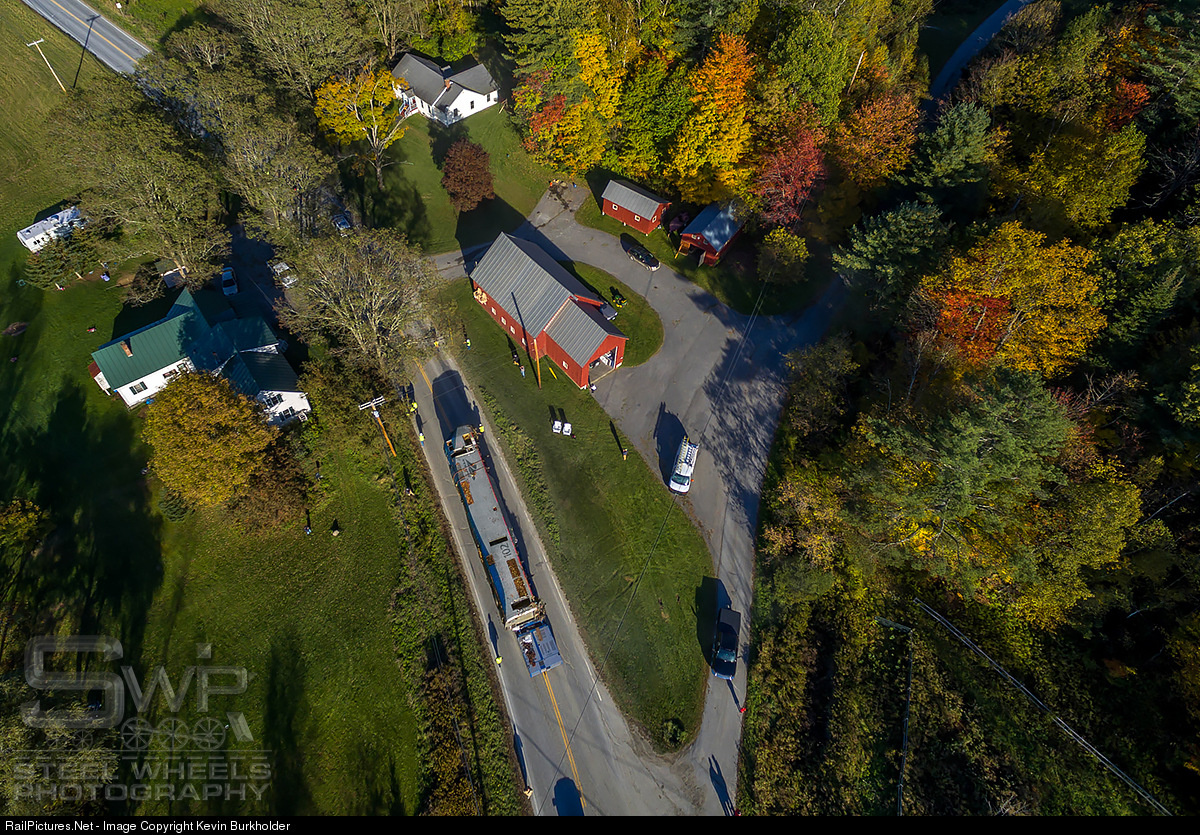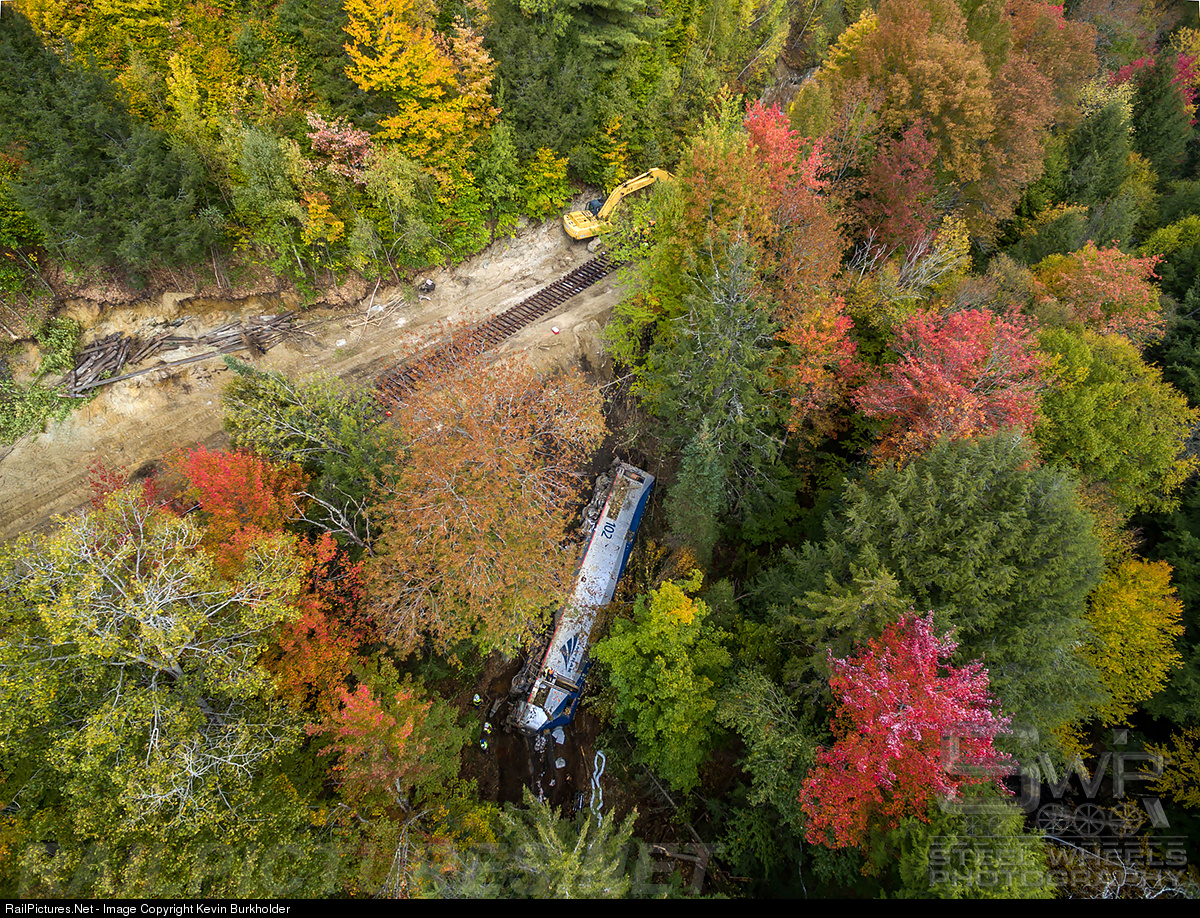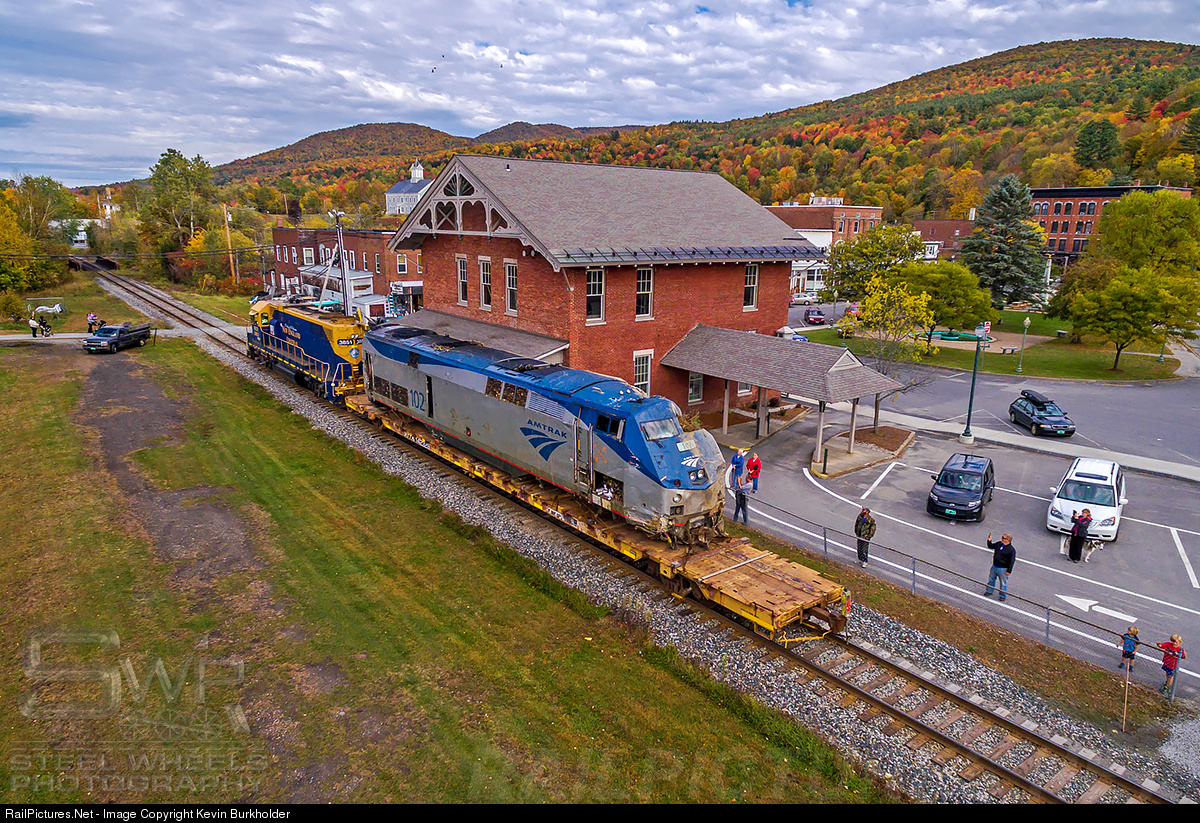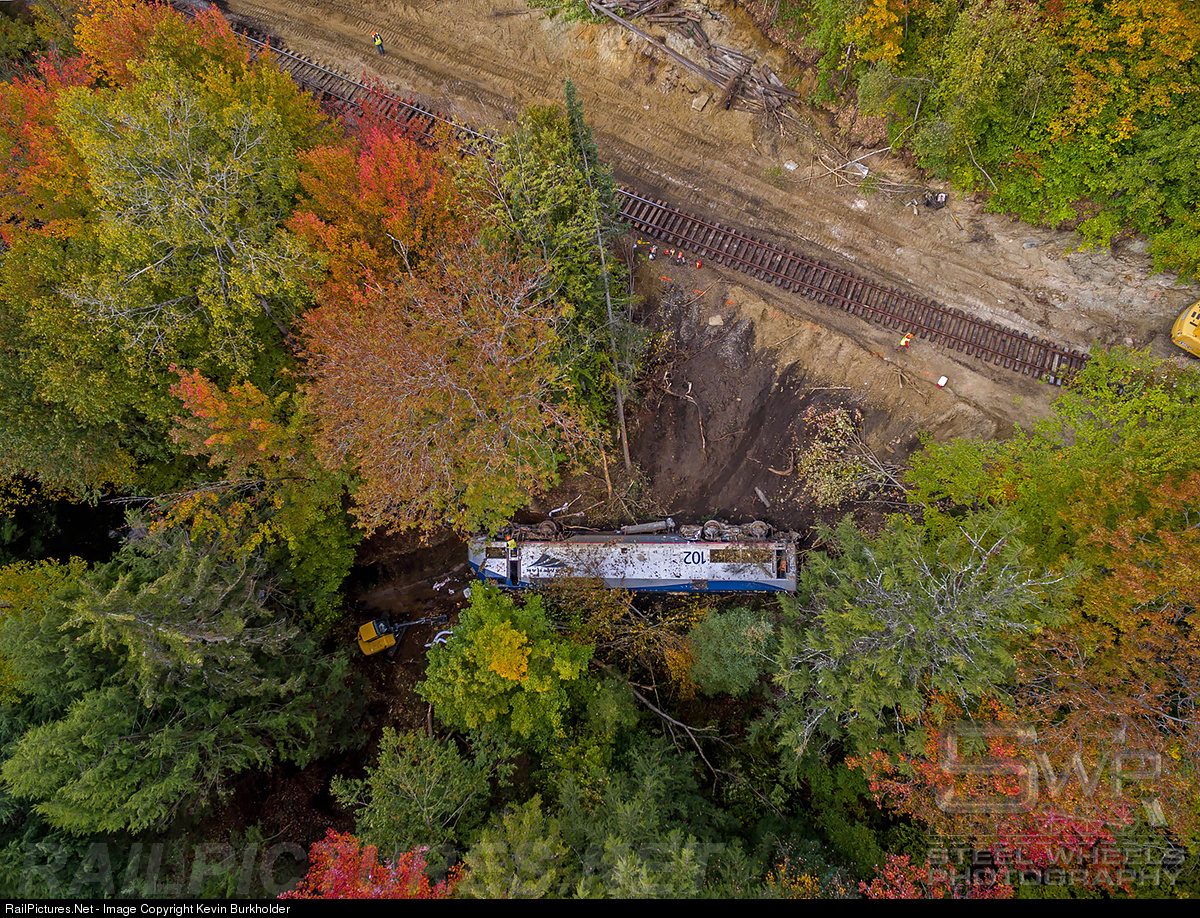Replies sorted oldest to newest
Both the Burlington Free Press and WPTZ-TV say that the Conductor was running the locomotive during yesterday's incident. Has anyone else heard this? Was the Engineer incapacitated and removed at Montpelier or earlier in the run? Are Amtrak Conductors now trained in the operation of locomotives? Does the BLET have a statement?
Jon ![]()
Both the Burlington Free Press and WPTZ-TV say that the Conductor was running the locomotive during yesterday's incident. Has anyone else heard this?
Fairly typical of today's media. They all seem to think that an "Engineer" is a BS Degreed designer if things, whereas EVERYBODY knows that the Conductor "drives the train"!
Was the Engineer incapacitated and removed at Montpelier or earlier in the run?
Probably not.
Are Amtrak Conductors now trained in the operation of locomotives?
Don't think so.
Does the BLW have a statement?
What is "the BLW"? Baldwin Locomotive Works, has generally been abbreviated as BLW.
Jon ![]()
OoopS Thanks Hot... I've edited my post.
Jon ![]()
I'm wondering what type of equipment is used in a situation like this to retrieve cars and an engine lodged down an embankment in an inaccessible area. Do they still use large railroad "big hooks" for this, or something else? It would be quite an operation to observe.


You would see several crawler tractors with short side cranes and a winch system to drag the units up grades where they would be relatively accessible to up right/scrap or load on flat cars.
Termed Sidewinders
Such crawlers are also used to lay and service pipelines
Both the Burlington Free Press and WPTZ-TV say that the Conductor was running the locomotive during yesterday's incident. Has anyone else heard this? Was the Engineer incapacitated and removed at Montpelier or earlier in the run? Are Amtrak Conductors now trained in the operation of locomotives? Does the BLET have a statement?
Jon ![]()
If the Conductor was not trained in the operation of a locomotive I'm sure he could run the engine just fine. Passenger trains are much easier to run than full tonnage freights. BLET Brotherhood of Local Engineman & Trainman.... would be my guess.
Both the Burlington Free Press and WPTZ-TV say that the Conductor was running the locomotive during yesterday's incident. Has anyone else heard this? Was the Engineer incapacitated and removed at Montpelier or earlier in the run? .......
Jon ![]()
FWIW ....
I heard Gov Shumlin use the term "conductor" when stating that it appears not to be human error. I think it was merely absentmindedness.
"According to Amtrak CEO Joseph Boardman, the person most seriously injured in the Monday derailment of the Amtrak Vermonter, a conductor who had been riding in the locomotive alongside the engineer, has been released from the hospital."
Such crawlers are also used to lay and service pipelines
Yes, but that's a completely different equipment rig and application from what's necessary for dragging a 275,000 lb. engine up a steep embankment.
Such crawlers are also used to lay and service pipelines
Yes, but that's a completely different equipment rig and application from what's necessary for dragging a 275,000 lb. engine up a steep embankment.
Not really. The various wreck/derailment clean-up contractors, like R J Corman and Hultcher do indeed use those "side-boom" crawlers that have been modified for such heavy work. Four of those modified side-boom Cats, can pick up a 400,000 pound locomotive without much trouble, and that all crawl away with it.
If you haven't been to any large railroad wrecks to witness how they do clean-ups now, you might want to retract your statement. These big side-boom rigs, the outside contractors use now are the reason that all the class one railroads have gotten rid of all the "big hooks".
As far as I know, the "big hook" has been retired from Class I wreck cleanup. There are several reasons that side-boom Caterpillar tractors are better:
- They can be driven on low-boy truck trailers, directly to (or very near to) the wreck site. The big hook required time to call a train crew on duty, round up the wrecking crew (Mechanical Department) get other traffic out of the way and get the hook to the wreck. Then, it was often necessary to build new track so the hook could get close enough to lift anything.
- They are manned by a team of contractor employees who work for and are trained by the contractor. They are not governed by hours of service laws (except for the truck drivers) and any injuries they might incur are outside of the Federal Employers' Liability Act, which applies to railroad employees.
- They purchase and maintain the equipment, which is modern and is periodically replaced with newer tractors, in contrast to the big hook, which is typically older than anyone working on it and is maintained by the railroad with custom-made parts.
- They are usually well-trained and well-practiced at their work. I personally have great admiration for the teamwork and skill of the crews of Hulcher, Inc., which we at the Santa Fe and BNSF used on a number of occasions. Once they start arriving, they go right to work, and, by the time the first lift is made, they have set up portable lighting, bladed some access roads, conferred with the railroad's wrecking boss (a Mechanical Department supervisor), have their cook trailer set up, and the side-boom cats can often roll right off of the low-boy and go directly to their first lift.
Such crawlers are also used to lay and service pipelines
Yes, but that's a completely different equipment rig and application from what's necessary for dragging a 275,000 lb. engine up a steep embankment.
Not really. The various wreck/derailment clean-up contractors, like R J Corman and Hultcher do indeed use those "side-boom" crawlers that have been modified for such heavy work. Four of those modified side-boom Cats, can pick up a 400,000 pound locomotive without much trouble, and that all crawl away with it.
If you haven't been to any large railroad wrecks to witness how they do clean-ups now, you might want to retract your statement. These big side-boom rigs, the outside contractors use now are the reason that all the class one railroads have gotten rid of all the "big hooks".
I'm sure they'll figure out a way to do that. It just seems it would be a challenge for the dozers to pull something that heavy up such a steep angle and over the embankment edge, and there's no place for the dozers to crawl away to, given the embankment on the upslope side of the tracks. There's very little room to work. In any case, it would be very interesting to watch the operation. Be nice to get some follow-up.
I watched a wrecker trying to pull a pickup up a steep and deep embankment once, with the cable coming up from the pickup down below, at a very steep angle and then curving at the edge of the embankment before going to the wrecker winch. It was the angle of the cable bending over the edge of the embankment that created all the additional force, and the wrecker couldn't pull it up.
The wrecker couldn't get enough traction to pull it, and apparently the winch wasn't adequate to try dragging it up. It also was unsafe to back the wrecker up to the edge of the "cliff" to get the boom over the side of the embankment to be able to lift up the pickup. When I left, they thought they might have to get a crane to retrieve it, or else a much bigger wrecker.
I'll make this a separate comment because it is a separate subtopic of this thread:
At a derailment, passenger cars have to be handled differently than freight cars. To get a covered hopper up an embankment, it can be dragged if necessary. It typically has a scrap value of $15,000 or less. It's always best to avoid any extra damage due to recovery, but freight cars are quite durable, and, if substantially intact when they come to rest, can stand to have a few things bent in retailing, if required. The main thing is to get the wreck off the main track and re-open it to traffic. Even locomotives, which have lifting lugs in many cases, can stand to have handrail or other exterior appliance damage at very fairly insignificant cost.
Passenger equipment, by contrast, is fragile. The frame is not fragile, but everything attached to it, on both the inside and outside, is fragile and very expensive. If there is any possibility of returning a passenger car to service, then great care in retailing it will save a lot of money. The passenger cars will be lifted instead of being dragged whenever possible, and cables will be carefully handled to keep them from further damaging siding panels. There are specific lifting points on every passenger car and locomotive
I e-mailed the local news anchor about the Conductor vis a vis Engineer issue. Here is her response:
On the conductor question from yesterday -- yes -- the conductor was the one in the first car and was the one airlifted to the hospital. He was most injured -- and from the first reports was behind the wheel. They hadn't been able to talk to him Monday, and at the newser didn't say much about him Tuesday. Something I'll look into though. So fortunate to have no loss of life.
I e-mailed the local news anchor about the Conductor vis a vis Engineer issue. Here is her response:
On the conductor question from yesterday -- yes -- the conductor was the one in the first car and was the one airlifted to the hospital. He was most injured -- and from the first reports was behind the wheel. They hadn't been able to talk to him Monday, and at the newser didn't say much about him Tuesday. Something I'll look into though. So fortunate to have no loss of life.
The media writers, i.e. "behind the wheel". Don't you just love it?????
.......and "the one in the first car". Think she was referencing the locomotive. Shheeeece!
Last railroad wrecker I saw was at Truckee, CA on the SP in about 2001, if I recall the year. And it was still steam powered! Thought the railroad may have retained it for lifts out in the Sierra Nevada mountains. Or it was heading to a museum - dunno.
The conductor may have been asleep at the wheel. ![]()
I didn't say he should , I just said he could run the engine just fine. I'm not a qualified engineman either but have run many heavy freights . Riding engines day after day and paying attention to the engineman and what's going on helps. I was fortunate to have worked with many engineman (probably over 50 of them) most of whom I admired .
If the Conductor was not trained in the operation of a locomotive I'm sure he could run the engine just fine. Passenger trains are much easier to run than full tonnage freights.
What??
The FRA would have something to say about a non-licensed person running a passenger train. And even if the conductor was an engineer he would have had to be qualified on the route by having made a run as engineer over it within the past 6 months.
I was on the Vermonter two years ago when it was annulled in Massachusetts due to a washout after heavy rains that afternoon in VT.
The engineer on our (northbound) train was a twenty-something female with two inch hoop earrings! Amtrak's operating crafts must not have the same rules about wearing jewelry as freight railroads. ![]()
The engineer on the southbound train happened to catch a ride back to VT on the bus that I was on. Interesting fellow to talk to - he started his railroad career as a gandy dancer on the Great Northern!
Update: According to the local news the Vermonter is back to full schedule. Haven't seen any pics of the wreck sight but that's a fast cleanup.
Re: the conductor, the conductor rides in the cab on freight trains, doesn't he? Not sure about the Amtrak, but if not the conductor, who is the second person in the cab?
Update: According to the local news the Vermonter is back to full schedule. Haven't seen any pics of the wreck sight but that's a fast cleanup.
Usually (I've been told), the first priority is to clear the line and get it opened again to traffic. Cars and engines may be pushed aside and left for retrieval later. So the term "cleanup" may may need to be qualified. Not sure about this situation, though. Be interesting to see what has actually happened so far.
Re: the conductor, the conductor rides in the cab on freight trains, doesn't he?
Correct, as there is no other place for him/her to ride.
Not sure about the Amtrak, but if not the conductor, who is the second person in the cab?
On passenger trains, the Conductor rides/works back in the train. Depending on the length of the Amtrak run, i.e. number of hours, there is an Assistant Engineer also in the cab with the Engineer, so that they can "trade off running". There may also have been an "Engineer-in-training" in the cab also.
Update: According to the local news the Vermonter is back to full schedule. Haven't seen any pics of the wreck sight but that's a fast cleanup.
According to "informed sources", the damaged passenger cars have been hauled out of the site, and the track restored. The problem now is the locomotive, which in the process of sliding down the bank towards the creek, struck a large tree,,,,,,,the tree won! The issue now is either to attempt dragging the severely damaged unit back up towards the right-of-way, or maybe drag it across the creek, or just scrap it in place and haul the various pieces out.
If scrapped in place would they salvage the prime mover and trucks ??
If scrapped in place would they salvage the prime mover and trucks ??
That would depend on what condition those components were in, plus what the insurance company would let them keep. Back well prior to my retirement, I was involved in estimating wreck repairs on EMD locomotives. Every time the repairs exceeded something like 50% to 60% of the price of a new locomotive, the whole thing was scrapped, period.
Was wondering what the relative value the various parts would have?? Would a good prime mover and trucks make up 50% of the value ?? Scrap yards seem to keep those parts. If the frame is bent there isn't much else keeping.
Here's an update.
The amazing crews, including R.J. Corman Derailment Services and Winters Rigging, working to recover the Amtrak P42DC 102 from the October 5 Vermonter derailment, got it loaded on a an automated lowboy trailer on October 10. The unit was moved from the wreck site to downtown Northfield, Vermont, where it will be loaded to a flatcar for transportation to Beech Grove, Indiana.
RailPictures photo of the wrecked P42 loaded on the trailer
Stuart
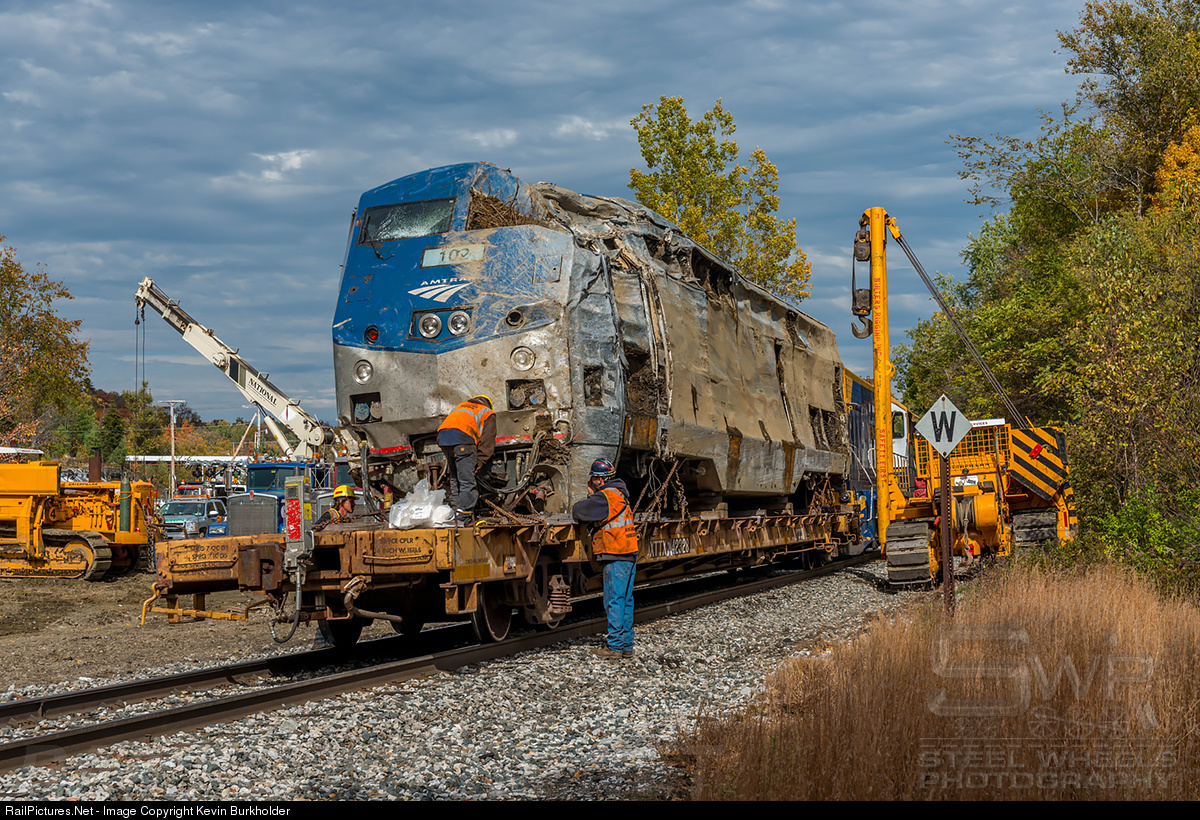
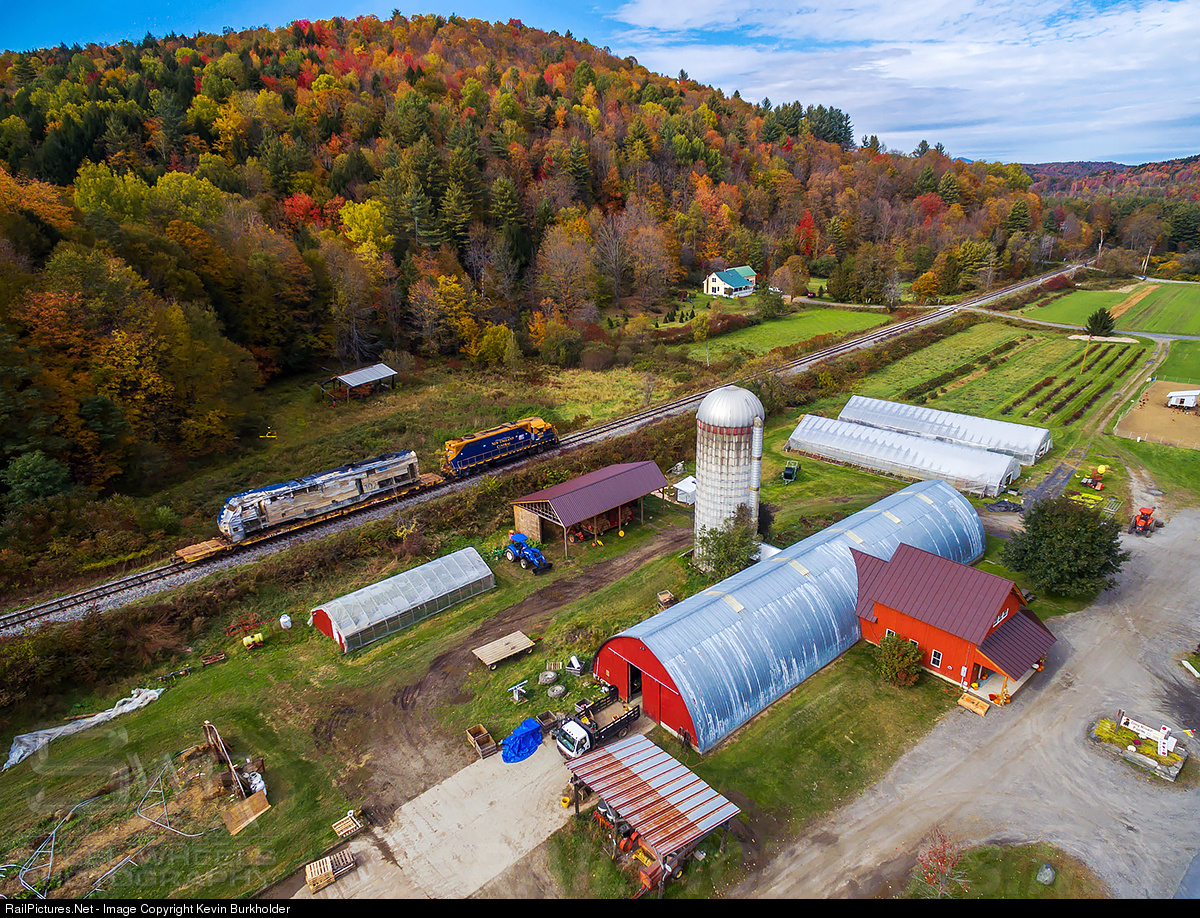
Doing this posting from a smart phone is not easy
Gary,
You're welcome.
![]() Mike CT
Mike CT ![]()
Note that sometimes these picture from rail sites like this go away. The wreckage aside, what a beautiful picture of Vermont. ![]()
Amazing how well the frame of the engne held up. Mostly bent tin on the outside. The aerial shot looks like a layout !! Who is first to model the wrecked loco and put it on a flat car ??
The question remains, and I'd be curious to know, how they got the engine from the gully to the point of being able to load it on a flatcar. That would be very interesting to see. The picture of the engine on the flatcar doesn't look like it's anywhere close to the crash site.
The question remains, and I'd be curious to know, how they got the engine from the gully to the point of being able to load it on a flatcar. That would be very interesting to see. The picture of the engine on the flatcar doesn't look like it's anywhere close to the crash site.
haven't found any pics of them removing the engine from the wreck site but they did load it on a flatbed and move it to the loading sight where it was placed on the flat car.

